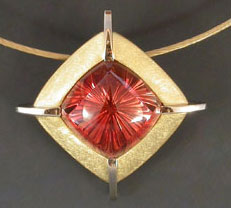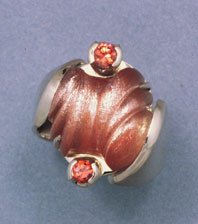Spring is a quiet time in the Berkshires. It is a time that we are to have time for creative work. At R. W. Wise, design usually begins with a gemstone. Gems are inspiring. If you talk nicely to a gem it will often talk to back to you and tell you what it would like to be.
This is part of the creative dialogue that goes on between the artist and his object.
This particular discussion started with a lovely sunstone that I found at John Dyer’s booth in Tucson, actually my wife Rebekah found it. Sunstone is a type of moonstone or crystalline feldspar. It is fairly durable and measures 6.5-7.2 on the Moh’s hardness scale which makes it a perfect choice for earrings or a pendant. Though some unique material is mined in Tanzania, the gems that I particularly like are mined in America, in Oregon toward the middle of the state, north of Plush. In 1987, Sunstone became the Oregon State Stone.
Sunstone comes in a range of hues, but medium to medium dark tones of orange-brown to brown-orange are characteristic of the Oregon material. Sunstone is something of a favorite among the exclusive fraternity of gem sculptors. New Hampshire gem-sculptor Michael Dyber has done some lovely carvings as has Larry Winn.
This latest entry is a cushion shaped cabochon (see above right) carved by the noted gem sculptor John Dyer. The technique is called reverse faceting. The facets are actually cut into the back of the stone. This causes a holographic affect when the gem is viewed through the top or table.


